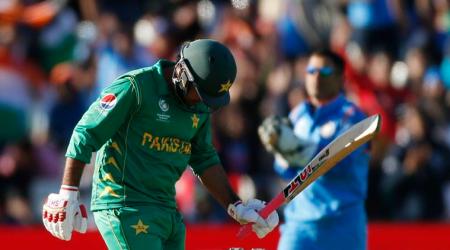 This year’s ICC Champion’s trophy sees Intel as the technology partner for the tournament. The company is using this platform to showcase their latest innovation “Bat Sense,” a device meant for professional players, and one that can be locked onto a bat. (Image source: Swapnil Mathur)
This year’s ICC Champion’s trophy sees Intel as the technology partner for the tournament. The company is using this platform to showcase their latest innovation “Bat Sense,” a device meant for professional players, and one that can be locked onto a bat. (Image source: Swapnil Mathur)
This year’s ICC Champion’s trophy sees Intel partnering up with the cricket association as the technology partner, and the company is using this platform to showcase their latest innovation, the “Bat Sense,” a device designed for batsmen in collaboration with Bangalore based company, Specular. The device is designed for professionals and aspiring batsmen alike and as such, will be priced at a Rs 10,000 when it launches in August, after being in development for almost 18 months. For now, Bat Sense is making its debut at the ICC, being used by a handful of batsmen in each team.
The Bat Sense is a little module that can be attached to the top of a cricket bat, blending seamlessly into the grip. The dongle has been designed to lock onto the bat and tested with forces up to 1500G so that it doesn’t fly off the handle. Powered by Intel’s Curie, Bat Sense allows batsmen to measure six important metrics of their batting performance; Maximum bat speed, bat speed at impact, backlift angle, time to impact, impact angle and follow through angle.
Speaking at the media briefing, Anuj Dua, Director of Marketing for Intel’s New Technology Group said, “The demand for a device that could measure a batsmen’s performance came directly from the coaches themselves.” As such, Bat Sense is designed to be an aide to the coaching process, instead of being a replacement for it.
The Bat Sense dongle connects via Bluetooth to any smartphone and transmits the batting data to a dedicated app. Intel and Specular have worked on the Bat Sense to be a device that can be used by both professionals and aspiring cricketers alike.
Addressing the challenges faced in a cricket academy, Atul Srivastava, CEO, Specular said, “Every coach has different requirements of data that they want to be able to go through from anywhere, because in today’s times, there is no concrete training data available for most cricket academies” [sic]. The idea behind Bat Sense essentially was to make a professional grade device that anyone interested in cricket could easily get a hold of.
 Making the module small and light required the team at Intel to come up with a hybrid material that would not only abstain from adding significant weight, but also be able to take a beating.
Making the module small and light required the team at Intel to come up with a hybrid material that would not only abstain from adding significant weight, but also be able to take a beating.
There is a slight difference between the Bat Sense module being used during the Champion’s Trophy matches and those which will be released commercially in the coming months. “The two modules are identical in every way except the radios. Since a batsman cannot take a smartphone into the field at the Champion’s Trophy, the modules being used in the matches are equipped with an X-band radio that communicates with the broadcaster’s booth. The commercially available units will ship with Bluetooth instead, but in terms of their performance, they are absolutely identical,” said Dua.
The development of the Bat Sense module came with a number of challenges. First, the team had to figure out where to place the module, so as to not violate any rules of the game. Once the placement had been finalised, the team had to ensure it was small, and light enough to not hamper with the batsman’s performance.
Making the module of such dimensions required the team at Intel to come up with a hybrid material that would not only abstain from adding significant weight, but also be able to take a beating. The second challenge was to differentiate between actual strokes of the bat from the practice swings batsmen usually take in between shots or while walking to the pitch.
This is where Intel’s ingenuity with algorithms came in. They setup a pitch with high speed cameras all around and asked a number of professional cricketers (current and former) to play 20-40 overs each. The bats were lined with LEDs so that the high speed cameras could track the motion with ease. Intel used this data to train the Bat Sense algorithms, allowing them to understand and identify all types of common strokes in the game of Cricket.
Bat Sense has been designed for professional use, but keeping the common audience in mind. Intel and Specular hope to see fast adoption of the technology across all cricketing markets upon launch, but are particularly optimistic about the feedback they have received from Indian cricket academies. The Bat Sense module goes on sale in August, and is expected to retail at a price of Rs 10,000.
Disclaimer: The correspondent is in Birmingham, attending Champions Trophy at the invite of Intel India, which is paying for travel, accommodation.

